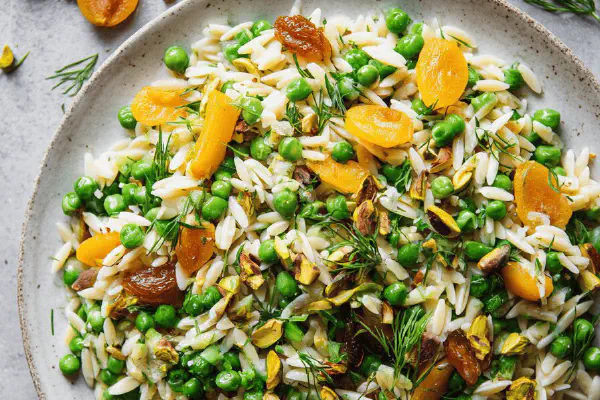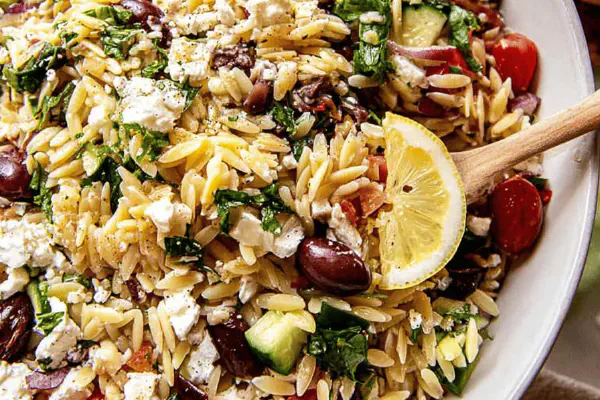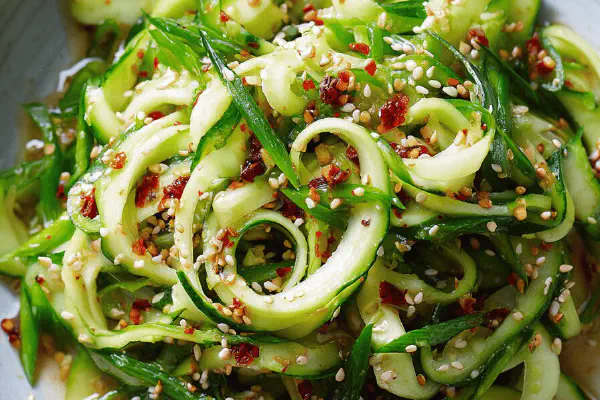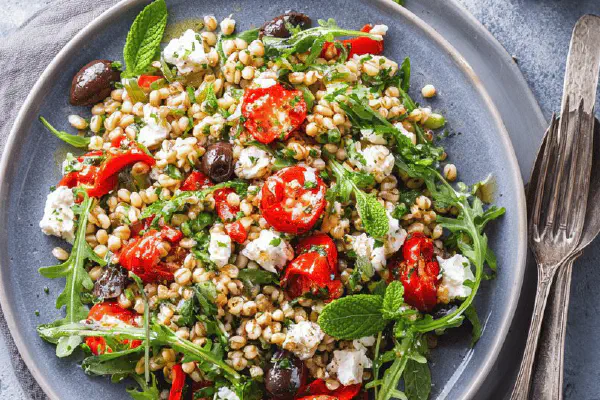Orzo Salad Peas Apricot

By Emma
Certified Culinary Professional
Ingredients
- 175 g orzo (about 1 cup) - reduced amount, keep bite firm
- 60 ml extra virgin olive oil (1/4 cup)
- 30 ml fresh lime juice (2 tbsp), swapped from lemon
- 10 ml Dijon mustard, grainy mustard replaced for brightness
- 400 ml frozen peas, thawed (1 2/3 cups) slightly less pea volume
- 100 ml toasted pistachios, roughly chopped (1/3 cup), replaced almonds
- 100 ml dried apricot, diced finely (about 1/3 cup) scaled down
- 3 scallions, white and green parts thinly sliced, more freshness
- Salt and freshly cracked black pepper, to taste
About the ingredients
Method
- Bring large pot of salted water to boil. Toss in orzo. Stir immediately to prevent sticking. Watch closely; pasta will bubble up. Taste after 7 min. Should be cooked but toothsome, not mushy. Drain quickly in colander, run under cold water briefly to halt cooking. Drain well. Drizzle with a splash olive oil, toss gently but don’t smush. Let cool to room temperature, spread on plate if crowded to speed cooling and avoid clumps.
- Meanwhile, in a small bowl, whisk olive oil, lime juice, and mustard until emulsified. Mustard graininess adds textural interest. Adjust seasoning with salt and pepper–think balanced, a touch sharpness against sweetness of apricots and creaminess of nuts.
- Combine cooled orzo in a large bowl with thawed peas, chopping a few peas roughly for subtle texture variance. Add pistachios and apricots, scatter scallions over top, fold everything gently but completely to distribute all flavors evenly. The contrast of soft orzo, crunchy nuts, and chewy fruit is key here. Taste the mix. Add more lemon/lime or oil if it seems dry. Rest at room temp 5–10 mins to marry flavors.
- Serve ambient or chilled. The salad holds well for hours but nuts may soften if refrigerated too long. For an extra twist, zest a lime on top or add fresh mint chopped fine for brightness. Tried basil once; too overpowering here. On lazy days, sub dried cherries or golden raisins for apricots but they shift sweetness profile. Pistachios bring a subtle earthiness vs almonds.
- Common misstep: Orzo left hot and oily clumps into a paste—spread out immediately to cool. Peas still frozen muddy texture—make sure fully thawed before adding. Mustard too timid? Add a pinch of smoked paprika for warmth without spice. Salt last, dry apricots small but potent, so go easy on additions each time you mix.
Cooking tips
Chef's notes
- 💡 Timing orzo super critical—boiling water salted well prevents bland pasta. Stir immediately once dropped in. Listen for bubbling to settle down, pasta ticking down to tender bite, not mush. Drain fast, rinse cold to stop cooking. Don’t skimp on oil drizzle after draining; stops clumping, helps dressing cling later.
- 💡 Mustard choice matters; grainy style adds texture and visual interest. Dijon works smoother but loses that subtle crunch. Whisk olive oil and acid vigorously till it emulsifies just enough, oil must coat orzo pieces fully. No separation means better flavor carry, no flat clumps in your mouth.
- 💡 Peas need full thaw, else mud mess. Roughly chop some peas for texture; doesn’t have to be neat. Apricots diced fine, moisture varies by brand—soak briefly if they feel dry to avoid chew bricks. Nut swap alters entire flavor, pistachios bring earthiness; almonds or walnuts change tone completely.
- 💡 Rest salad 5 to 10 minutes at room temp, flavors marry, nuts soften a little but stay crunchy. Skip refrigeration long—nuts soften too much, overall texture dulls. Toss gently only after adding fruit and nuts to keep texture contrast intact. Don’t fold overdo or break fruit bits.
- 💡 Lime juice over lemon changes everything, sharper acid cuts sweetness more cleanly. Tried adding smoked paprika for warmth when mustard too timid—adds depth without heat. Salt at end after tasting; dry apricots punch saltiness, don’t dump in early. Always adjust last, especially if serving alongside salty foods.
Common questions
How to avoid mushy orzo?
Listen to bubbling water. Stir right away. Taste at 7 minutes; toothsome bite is key. Rinse in cold water fast to halt cooking. Drain well. Don’t skimp oil post-drain or pasta sticks.
Can I replace pistachios?
Yes, almonds or walnuts work but flavor shifts earthiness. Walnuts can be bitter; almonds milder. Toast nuts lightly for crunch, or buy toasted. Never skip nuts, texture crucial here.
Why does salad get mushy in fridge?
Nuts soften over time, peas lose bite. Orzo absorbs dressing too much. Chill briefly only or keep room temp a few hours. Store airtight, nuts stale fast; refresh with toast if needed.
Best way to store leftovers?
Airtight container in fridge up to 2 days max. Bring to room temp before serving for flavors to bloom again. Toss gently after resting. If nuts dull, toast quick in pan to revive crunch.



